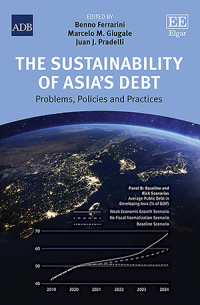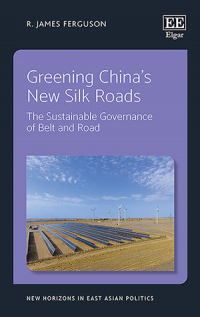Hardback
The Sustainability of Asia’s Debt
Problems, Policies and Practices
9781800883710 Edward Elgar Publishing
This is an open access title available under the terms of a [CC BY 3.0 IGO] License. It is free to read, download and share on Elgaronline.com.
Asia has shown the world what success in economic development looks like. From the amazing transformations of Japan, the Republic of Korea, and the other ‘tigers’ in the early 70s, to the more recent takeoffs of the People’s Republic of China (PRC), India, and the leading economies in Southeast Asia, the region has prospered at a startling pace. Technologies were adopted, productivity raised, and export markets conquered. Billions were lifted out of poverty. What was once a backwater is now a global engine of growth.
Asia has shown the world what success in economic development looks like. From the amazing transformations of Japan, the Republic of Korea, and the other ‘tigers’ in the early 70s, to the more recent takeoffs of the People’s Republic of China (PRC), India, and the leading economies in Southeast Asia, the region has prospered at a startling pace. Technologies were adopted, productivity raised, and export markets conquered. Billions were lifted out of poverty. What was once a backwater is now a global engine of growth.
More Information
Critical Acclaim
Contributors
More Information
Asia has shown the world what success in economic development looks like. From the amazing transformations of Japan, the Republic of Korea, and the other ‘tigers’ in the early 70s, to the more recent takeoffs of the People’s Republic of China (PRC), India, and the leading economies in Southeast Asia, the region has prospered at a startling pace. Technologies were adopted, productivity raised, and export markets conquered. Billions were lifted out of poverty. What was once a backwater is now a global engine of growth.
咆哮的进展,然而,受乐sser-known factor: borrowing. Governments, corporations, and households financed their path to prosperity with debt—lots of debt. Today, the volume of debt hanging over Asian economies is huge, in both absolute and relative terms. It was growing fast before the pandemic and is projected to grow even faster because of it. Demography is bound to make matters worse in the long term. How sustainable is this? What should policy makers do to keep Asia’s finances stable? Should markets worry? These are the core questions of this book.
通过一系列的章节由著名擅长ts, a diagnosis of Asia’s debt accumulation is offered. The approach is both country- and issue-driven, so both idiosyncratic and common elements can be identified. Matters like Japan’s social insurance promises, the PRC’s state-owned enterprises, the Pacific islands’ aid dependency, and the saving habits of households in the Republic of Korea are dissected. As are trends that are present across countries, such as population aging, shrinking fiscal space, and contingent liabilities. This allows for a deeper understanding of what makes borrowing sustainable—or not. And it leads directly into policy recommendations, especially those involving the use of new financial instruments.
The final product is a book whose comprehensiveness and practicality are unprecedented in the field. It will be equally invaluable for governments, investors, and scholars in Asia and beyond.
咆哮的进展,然而,受乐sser-known factor: borrowing. Governments, corporations, and households financed their path to prosperity with debt—lots of debt. Today, the volume of debt hanging over Asian economies is huge, in both absolute and relative terms. It was growing fast before the pandemic and is projected to grow even faster because of it. Demography is bound to make matters worse in the long term. How sustainable is this? What should policy makers do to keep Asia’s finances stable? Should markets worry? These are the core questions of this book.
通过一系列的章节由著名擅长ts, a diagnosis of Asia’s debt accumulation is offered. The approach is both country- and issue-driven, so both idiosyncratic and common elements can be identified. Matters like Japan’s social insurance promises, the PRC’s state-owned enterprises, the Pacific islands’ aid dependency, and the saving habits of households in the Republic of Korea are dissected. As are trends that are present across countries, such as population aging, shrinking fiscal space, and contingent liabilities. This allows for a deeper understanding of what makes borrowing sustainable—or not. And it leads directly into policy recommendations, especially those involving the use of new financial instruments.
The final product is a book whose comprehensiveness and practicality are unprecedented in the field. It will be equally invaluable for governments, investors, and scholars in Asia and beyond.
Critical Acclaim
‘This is an important book, for at least three very different reasons. First, it provides an excellent, and very recent, analysis of debt accumulation in a region whose financial stability matters to the entire world. Second, it explains in an easy-to-understand way the role that borrowing has in the behavior of governments, corporations, and households. And, third, it introduces the reader to new and powerful financial instruments that can benefit not just lenders and borrowers but society as a whole. A must read.’
– Allan Rosenbaum, Florida International University, US and President of the American Society for Public Administration
– Allan Rosenbaum, Florida International University, US and President of the American Society for Public Administration
Contributors
Contributors include: Phillip Anderson, Jérémie Cohen-Setton, Alexandre Dayant, Luis de la Plaza, Nicolas Depetris-Chauvin, Klaus Enders, Benno Ferrarini, Marcelo M. Giugale, Farah Imrana Hussain, Timothy C. Irwin, Sang-Hyop Lee, Lili Liu, Andrew Mason, Keita Oikawa, Juan Pablo Paladino, Ugo Panizza, Donghyun Park, Juan Pradelli, Andrea F. Presbitero, Maria Teresa Punzi, Roland Rajah, Hernán Daniel Seoane Bernadaz, Mi Xie, Ninghua Zhong





